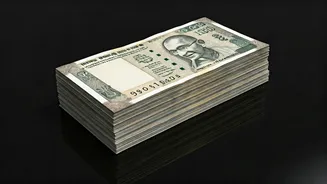Reserves Under Review
The most recent data indicated that India's foreign exchange reserves had decreased by a substantial $6.93 billion. This decline brought the total reserves to $695.36
billion. This figure encompasses the country's holdings of foreign currencies, gold, special drawing rights (SDRs) and its reserve position in the International Monetary Fund (IMF). Fluctuations in these reserves can be influenced by a myriad of factors, including global economic conditions, the value of the Indian rupee, and trade dynamics. Analyzing these factors provides crucial insights into the health and stability of the Indian economy and its position within the international financial landscape. The movement in reserves can have wide-ranging implications, impacting everything from import capabilities to the stability of the rupee's exchange rate.
Global Economic Climate
The global economic climate plays a critical role in shaping India's foreign exchange reserves. Developments in other countries, particularly the actions of major central banks like the U.S. Federal Reserve, have significant ripple effects. For instance, as hopes for a US Federal Reserve rate cut in December faded, the Indian rupee experienced a sharp decline. This depreciation can make imports more expensive, potentially influencing the outflow of foreign exchange reserves. Moreover, global trade dynamics and the demand for Indian exports influence the inflow and outflow of foreign currency. Factors such as geopolitical events, commodity price fluctuations, and changes in global investor sentiment can all contribute to the volatility of reserves. Understanding these external influences is essential for analyzing the reasons behind reserve movements and assessing the economy's resilience.
Domestic Fiscal Performance
India's domestic fiscal performance also affects its foreign exchange reserves. The government's fiscal deficit, which is the difference between its spending and its revenue, is a critical indicator. In the period from April to September, the fiscal deficit reached ₹5.73 trillion, equivalent to 36.5% of the estimate for the fiscal year 2026. This indicates the government's borrowing needs, which can have implications for the balance of payments. A higher fiscal deficit may lead to increased borrowing, potentially influencing the demand for foreign currency. The government's focus on export diversification, as highlighted by Piyush Goyal, also plays a crucial role. Efforts to expand India's export markets and reduce reliance on specific trade partners are essential for boosting foreign exchange earnings. Additionally, industry's advocacy for long-term deals and government support for agricultural inputs, such as Di-ammonium phosphate (DAP), under recoveries, may also impact the economic landscape, although the direct effects on foreign exchange reserves might not be as pronounced.
Import and Trade Licenses
A further point of consideration is the acquisition of Chinese licenses by some Indian companies to facilitate the import of rare earth materials (REMs). This action, as noted by the Ministry of External Affairs (MEA), underscores aspects of trade relations and imports. When analyzing the dynamics of foreign exchange reserves, understanding the implications of import activity is crucial, and it can affect the overall current account balance. The volume and value of goods, including these strategically vital REMs, imported from other nations have a direct impact on the currency reserves. When import payments exceed export earnings, the foreign exchange reserves could be depleted to fill the gap. Therefore, these import-related factors play a significant role in determining the health and performance of India's foreign exchange reserves.

















